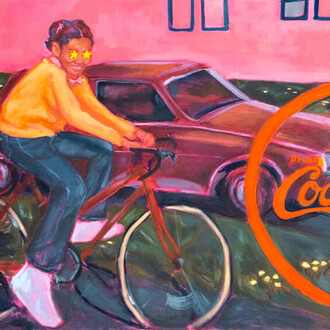Hometown is proud to present A Jealous Person, an exhibition of paintings by Andrea Joyce Heimer. This will be the gallery’s first solo exhibition, and Heimer’s first solo exhibition in New York. The show features a new body of work by the artist, all relating to that timeless albatross of human emotions, envy.
Andrea Joyce Heimer is a story teller. From the banalities of suburban life, to puppy love and the awkwardness of adolescence, to soul-searching (and tripping on hallucinogens) in the wilderness, to visions of an expansive unicorn orgy, it seems nothing is unimaginable or off limits. But even at their most fantastical, Heimer’s narrative paintings are nonetheless steeped in underlying personal content. For this exhibition, Heimer turns to an emotion that has affected her in any number of ways.
Whether Heimer is portraying specific memories or invoking the past more generally through fictional subjects, autobiography is central to her practice. For Heimer, painting has from the start been a way of coming to terms with—or at least of meditating on—different aspects of her life, often with a focus on her youth. This requires honesty, first with herself, then with the viewer. And to this end, Heimer’s work often reveals certain things about the artist—dreams, desires, flaws—that many of us would be too bashful to share about ourselves (but with which we can probably empathize).
At their most forthcoming, Heimer’s paintings illustrate significant situations she's experienced that used to be, and sometimes still are, top of mind. In "My Sister's Bush Was Glorious And Full And The Color Of Campfire Flames While Mine, Still Struggling Through Puberty, Was Patchy And Mousy And In Her Presence I Felt Like An Unfinished Drawing.", for instance, not only does the work’s vivid title provide an insightful prologue to the painting—which Heimer’s titles often do—but an important dynamic from Heimer’s childhood is conveyed through this playfully embellished family scene.
You see Heimer was adopted, and her sister was not. And growing up, her sister was confident and comfortable in her own skin, while Heimer herself often felt shy and unsure—as she once described it, like an “outsider in her own backyard.” As the records of her biological parents are unavailable to her, Heimer naturally developed a strong desire to know about—and a frequent habit of fantasizing about—the past. This curiosity feeds directly into Heimer’s paintings, where she’s free both to ponder and to mythologize this highly personal terrain. In "Sister," the work mentioned above, a young Heimer stands alone in her family’s upstairs bathroom, self-consciously inspecting herself in the mirror, while the rest of the family is downstairs at the dinner table, raising their glasses in a toast to her sister, who stands proudly on the table, nude and statuesque.
This imperfect relationship with the past is echoed, deliberately, in Heimer’s chosen style of representation. She typically works with acrylic paint and pencil, drawing figures in a simplified or caricatured manner, and rendering spaces—the rooms in a house, fields on a ranch, the desert—unbound by the rules of perspective. As memory functions more as a patchwork of key moments than as a complete biographical record, Heimer brings our focus to the broader emotional tenor, and to the essential roles played by the people, places, and things in her world.
In Heimer’s more densely packed compositions, there is a sort of horror vacui, as if there’s too much to say—or too much that could go unsaid—in the finite rectangle of the painting. Heimer herself has recognized this challenge, along with the value of symbolism as a visual shorthand. She has also taken to giving her paintings rich, descriptive titles which are written beside the works directly on the gallery wall. Heimer’s content thus overflows—and is annexed beyond—the painting itself.
One of the exhibition’s more populous paintings, "I Am Jealous Of Everyone You Have Ever Been With And There Have Been Many, And Then I Find Out Some Of Them Were Squirters And I Am Undone By This Knowledge. It Weighs On Me Like A Stone.", depicts a room cluttered with the naked bodies of numerous women Heimer imagines a lover to have slept with, ostensibly leaving little space for much else. Yet Heimer has also included her lover, front and center, various furniture and other items recalled from her childhood home, and multiple patterned and decorated surfaces throughout the scene. In this allegorical environment, inanimate objects can become characters in their own right.
Heimer shows us a lot about herself in her paintings, to the point of generosity, but she’s rarely a participant in her own stories. Instead, Heimer is the one who observes, from a safe distance, as others effortlessly enjoy themselves—the one who wonders about, and yes, envies, the kinds of lives others have without the burden of her limitations. But with that separation, there seems to come a certain clarity to the way Heimer sees the people and experiences that have for so long been, seemingly, out of reach. There’s also a remarkable humor in these works—in their titles, in Heimer’s particular visual language, and in the improbable events that Heimer presents without filter—suggesting a narrator who has come a long way from the girl who used to hide out upstairs during family dinners.
Andrea Joyce Heimer was born in Great Falls, Montana, and she lives and works in Ferndale, Washington. Heimer has been a self-taught artist for most of her career, and is currently earning an MFA from the New Hampshire Institute of Art, 2017. Heimer’s work has been exhibited extensively in the United States and abroad, including at venues such as Andrew Edlin Gallery, New York, NY; Antonio Colombo Gallery, Milan, IT; Kunsthal Charlottenborg, Copenhagen, DK; Lindsay Gallery, Columbus, OH; CG2 Gallery, Nashville, TN: Linda Hodges Gallery, Seattle, WA; Castlefield Gallery, Manchester, UK; Maxwell Colette Gallery, Chicago, IL; and Subliminal Projects, Los Angeles, CA.









